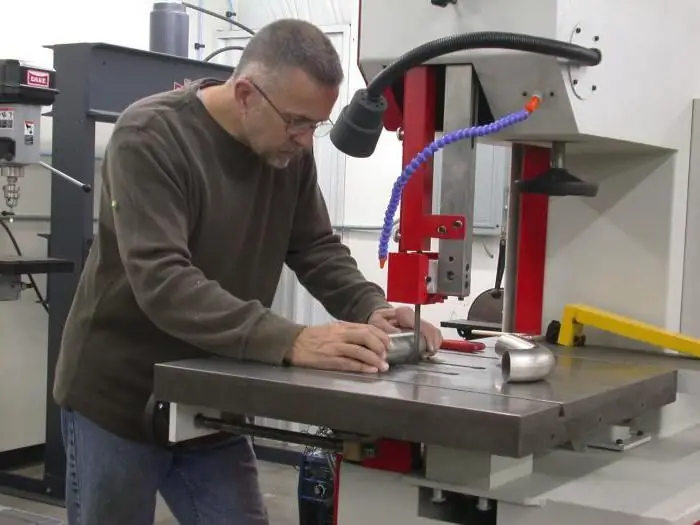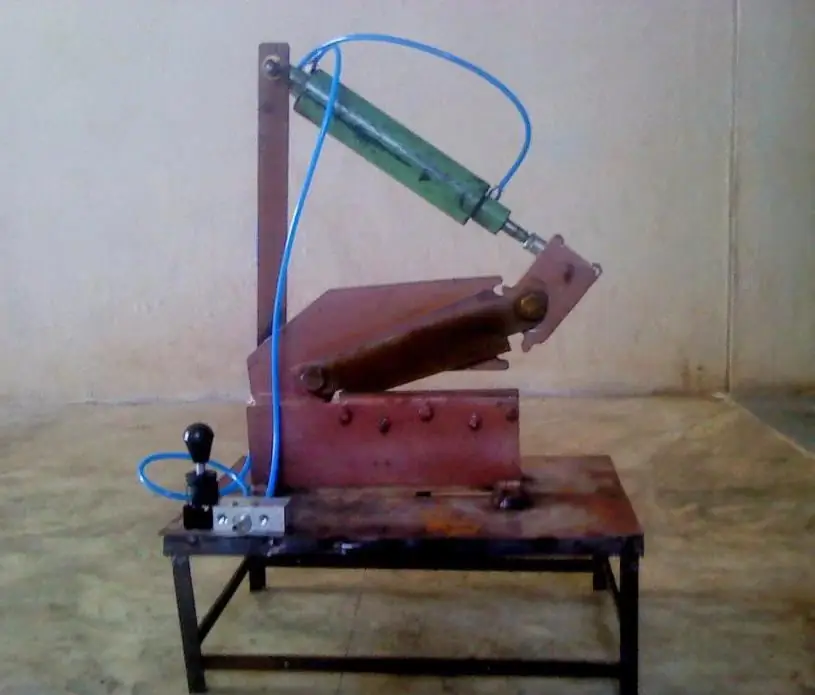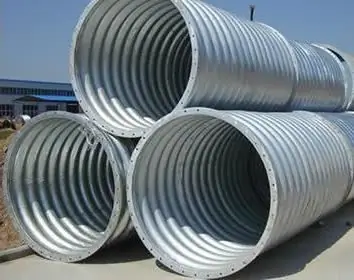2025 Author: Howard Calhoun | [email protected]. Last modified: 2025-01-24 13:10:45
Metal corner - a product widely used in industry, in the construction of buildings and structures, as well as in other areas of the national economy. Due to the special design, this type of rolled product has increased rigidity and can be used to assemble frames with a large margin of safety. It is a corner of a long steel product, in cross section resembling the letter "G". There are only two of its main types: equal-shelf and unequal-shelf. In the first case, the width of the "shelves" of the products is the same, in the second - different. The dimensions of the metal corner, its weight and the type of material used for the manufacture are regulated by GOST.

Classification
Equal and unequal corners can be:
- hot-rolled (produced according to the standards prescribed by GOST 8510-86 and GOST 8509-93);
- bent (GOST 19771-93 and GOST 19772-93).
The first variety is characterized by increased strength. Such a corner is usually used in the construction of metal structures,subjected to increased stress. Bent corners are the most popular. They are used everywhere. They are made by bending steel strips on special pressing equipment.
Also these metal products are classified into:
- standard;
- high precision.
The first variety is marked with the letter "B", the second - "A".

Metal angle length
According to this parameter, products are classified into measured and non-dimensional. There is also a corner of a multiple length and limited. Measured products can have a length of 6, 7, 9, 10, 11 or 12 m. Their cost depends on weight (that is, the consumer pays not for a unit of product, but for the total weight of the purchase or, in extreme cases, for the footage). An unmeasured corner can be of any length. In this case, this figure varies from 4 to 12 m. Most often, building materials of this type are not too long, as they are often just trimmed dimensional products.
Sometimes in the manufacture of various kinds of frames, load-bearing structures, etc., it is required that the dimensions of the metal corner be non-standard. In this case, the consumer has the opportunity to order products longer than 12 m.
Length errors
Among other things, GOST also regulates the limit deviations of the angle for this parameter. The latter should not be more than:
- 30mm for 4m angle;
- 40 mm for products up to 6 m;
- 70mm for 6m to 12m angle.
At the request of the customer, these parameters can be changed towards greater accuracy (40 mm for products 4-7 m plus 5 mm for each meter of length over 7 m). GOSTs regulate not only the dimensions of the equal-shelf and unequal-shelf metal corner, their weight and maximum deviations, but also the degree of their curvature. After all, quality products must be smooth. The maximum value of the curvature of the corner according to GOST should not exceed 0.4% of the length. At the request of the customer, enterprises engaged in the production of rolled metal produce products with a curvature of no more than 0.2% of the length. Twisting of the corner in the direction around the GOST axis does not allow.

Shelf width and weight
What, in fact, can a metal corner have dimensions? GOST regulates primarily the ratio of the width of the shelves of these products, their thickness and weight. The first indicator varies from 20 to 200 mm. The thickness of products can reach 16 mm. What exactly should be the ratio of the width of the shelves and the weight of 1 linear meter of the product, see the table below.
| Shelf width (mm) | Thickness of steel used for manufacturing (mm) | Weight (kg) |
| 30 | 3-4 | 1.36-1.78 |
| 35 | 3, 4 or 5 | 1.6, 2.1 or 2.58 |
| 40 | 3-5 | 1.85, 2.42, 2.98 |
| 50 | 3, 4, 5, 6 | 2.32, 3.05, 3.77 |
| 70 | 4.5, 5, 6, 7, 8 | 4.87, 5.38, 6.39, 7.39, 8.37 |
Above are the ratios of values for equal-shelf products. As you can see, with the same width of the shelves, their thickness can be different. Accordingly, the weight of the product also changes. The dimensions of the metal unequal corner, or rather, the width of its "shelves", can also vary within 20-200 mm. The ratio of this parameter and the weight of products in this case is regulated by GOST and is indicated in special tables.

Steel grades
The strength of a metal corner depends not only on the method of its manufacture, the thickness and width of the shelves. It affects this parameter and what kind of material was used to manufacture the product. They make a corner from the following types of steel:
- carbon regular quality;
- high strength low alloy.
In the first case, metal grades are used, the operational characteristics of which are regulated by GOST 380-88. The quality of low-alloy steels used for the production of angles is determined by GOST 19281-89.
Most popular metal corner sizes
The most demanded products of this type are products bent from ferrous metal grade "B". This option is cheapercorner from stainless steel of a class "A". At the same time, such corners have a sufficient margin of safety so that durable and reliable structures can be assembled from them.

What are the most popular sizes of a metal corner? 40 x 40 mm, 50 x 50, 70 x 70 and 100 x 100 mm are the most popular shelf widths. The first version of the products, for example, can be used for the manufacture of awnings, gazebos, benches, outdoor tables, etc. For not very responsible structures, such a corner has a sufficient margin of safety.
Products 50 x 50 mm can be used in the assembly of fences, gates, gratings, small children's swings, etc. This material is also used in mechanical engineering, as well as in the assembly of railway cars. The dimensions of the metal corner 50x50x5 mm or 50x50x6 mm allow you to assemble various kinds of frames that experience small loads. In other cases, a less durable version of 50 x 50 x 3 or 50 x 50 x 4 mm can be used. Such a corner weighs more, and therefore costs less.
Zinc plated steel angle
Very often rolled metal of this type is used to assemble metal structures that are exposed to moisture during operation. Since ordinary steel is susceptible to corrosion, in this case a special type of metal corner is often used - galvanized. This option is quite expensive, but even in the most difficult conditions it can last for decades. The dimensions of the metal corner of this variety (width and thickness of the shelves)are the same as the usual.

Products of this variety are most often made of carbon steel. Zinc plating can be done in several ways. With a simple immersion of the corner in the melt, products are obtained with a protective layer thickness of 150 microns. Sometimes galvanizing is carried out in a rotating sealed container at high temperatures. In this case, the zinc penetrates the top layer of the steel and, although its layer thickness is also 150 microns, it holds much better. Steel can also be coated with this metal by spraying. At the same time, it is possible to apply a much thicker layer of zinc - up to several millimeters.
Recommended:
Metal band saw. Metal cutting machine

Metal band saw is a high-performance equipment that is responsible for a variety of functions, such as cutting metals and cutting a variety of strong and high-strength materials
Sheet metal cutting: description, types. metal bending

Today, sheet metal cutting is one of the fairly common technological processes that allows you to get blanks of the desired size and shape. However, there are many methods for performing this procedure and a wide variety of equipment
Types and diameters of metal pipes. Metal pipes of large diameters

Steel pipe is a cylindrical tube and is the most used product in the steel industry. The main use of steel pipes is to transport oil, gas and water over long distances. In household appliances, such as refrigerators, ordinary steel pipes are used, as well as in heating and water supply systems
Railway track is Definition, concept, characteristics and dimensions. Train dimensions and features of track facilities operation

Traveling by train through cities and towns, you can learn a lot of interesting and amusing things about the world of the railway. More than once, traveling people have asked themselves questions about where this or that railway track leads? And what does the engineer who manages the train feel when the train is just starting off or arriving at the station? How and from where do metal cars move and what are the ways of the rolling stock?
Dimensions of wooden railway sleepers. Reinforced concrete sleeper: dimensions

The production of railway sleepers in the Russian Federation is regulated by strict state standards. This applies to both wooden and reinforced concrete structures. What are the specifics of the standards governing the dimensions of both types of sleepers?

